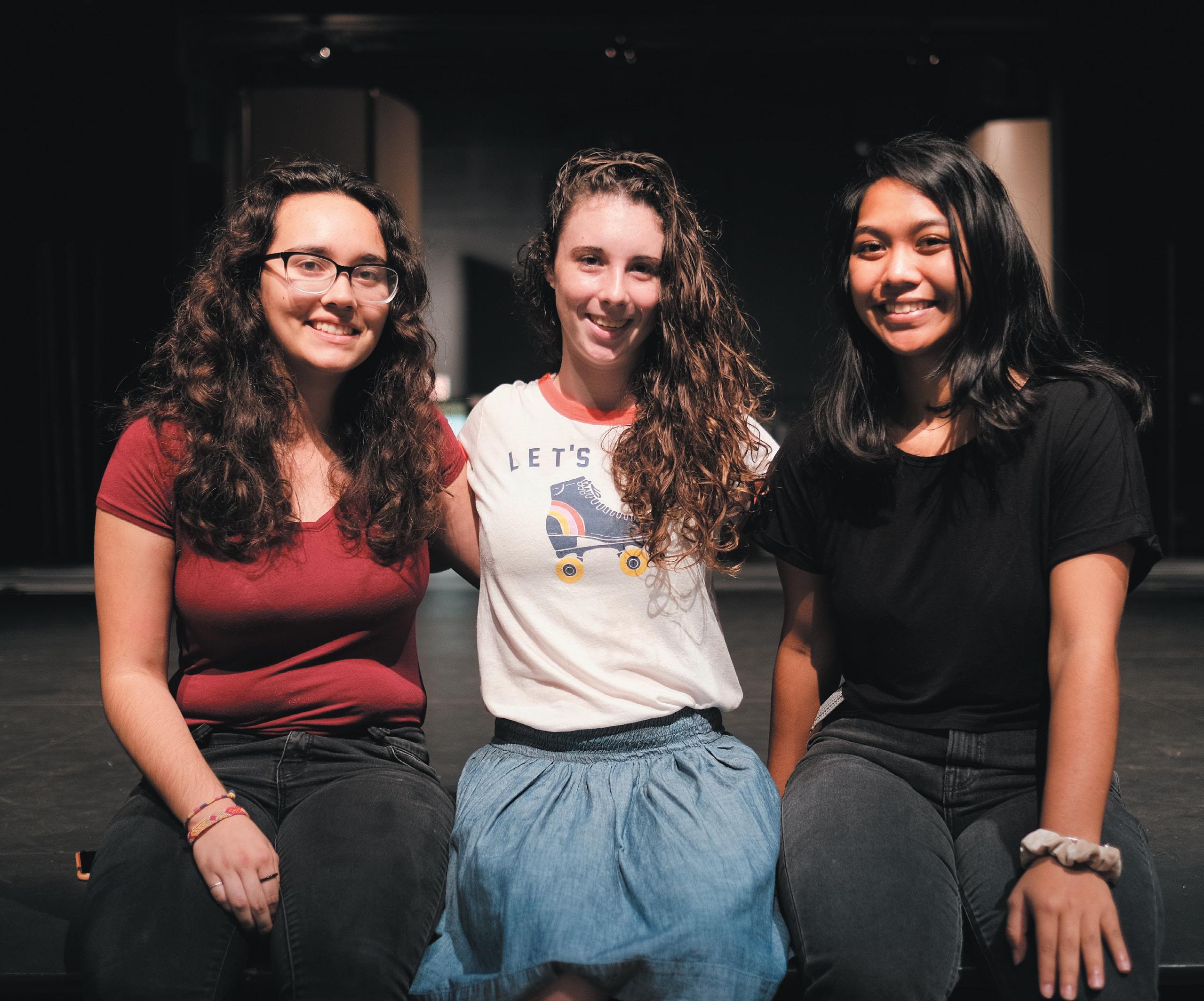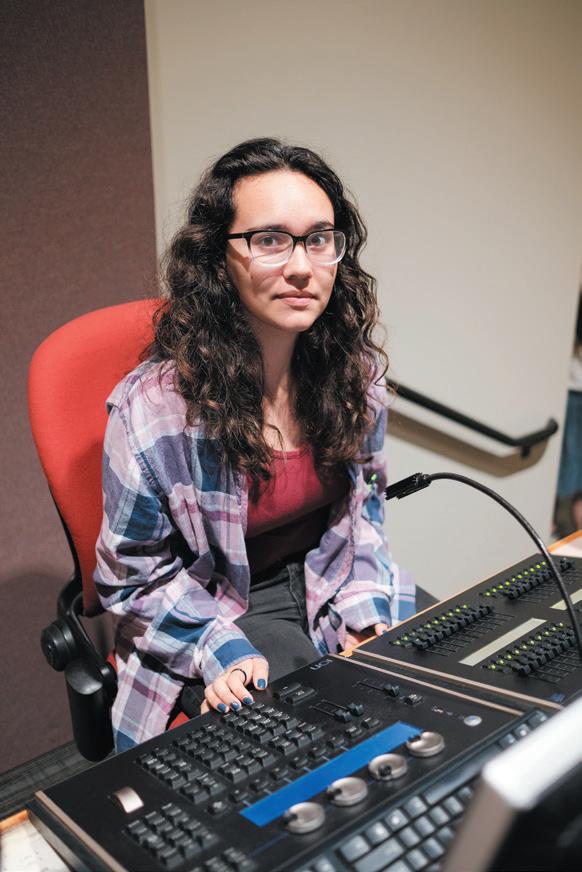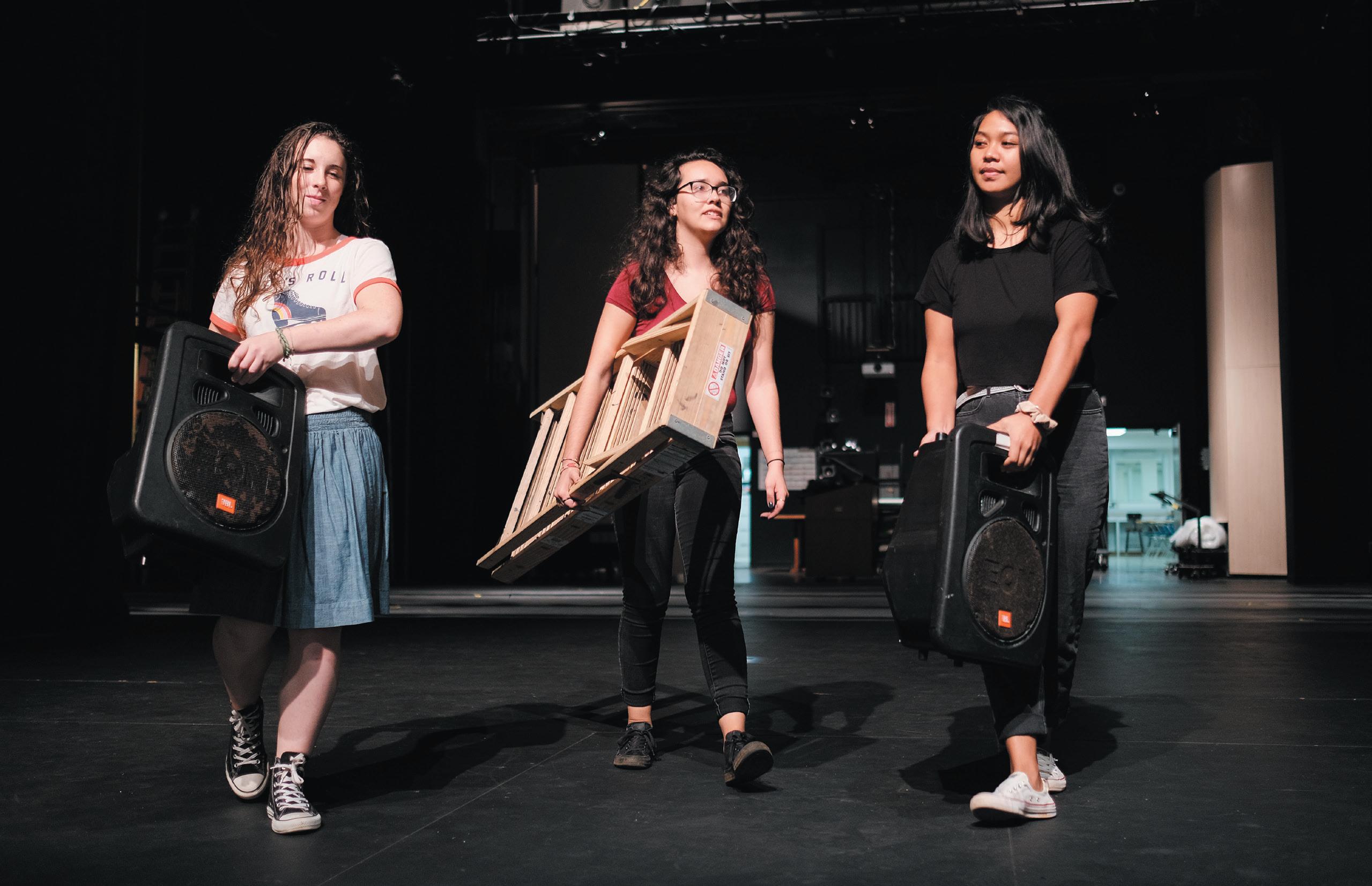
6 minute read
The unseen members of the theater
Left to right: Lucy Torres, Alexia Kaley and Miha Mortensen work behind the scenes in the McKay Auditorium and say they love helping performers shine but need to think on their feet when technical things go wrong.

Auditorium employees describe stagehand work as challenging but exciting
BY HAELEY VAN DER WERF
Behind every performance in the McKay Auditorium is a dedicated crew of stagehands, several of whom explained how while they need to be adaptable and think quickly, they do it because they love the theater, and they want to share the talent of BYU–Hawaii students.
Alexia Kaley, a junior from Texas majoring in secondary education for history, said, “I think people should know while we like to mess around, we take our jobs seriously. We love theater so much, and we love getting to share the talent on this campus with everyone.
“It’s important everyone acknowledges we exist. This isn’t something we volunteer for. We put in 19 hours a week, and sometimes even more just to make sure we get to share this with everyone.”
Stephen Crowell, McKay Auditorium manager, shared how people don’t see [the stagehands] most times. “That’s how it should be. Everyone’s attention should be on the performance. We are not supposed to be the individuals who get seen or get acknowledged. For the general audience, if I see them smile, applaud or receive joy in some way, then I know I have accomplished my part of that production.”
What stagehands do
Lucy Torres, a junior from California majoring in elementary education, explained their official title is stagehand. “We do all the setup and striking as well as the technical side. We make sure all the shows run smoothly.” Describing how being a stagehand at BYUH is different from most places, Kaley said, “A theater tech basically does a bit of everything. In most theater departments you would specialize in something. You would be a light tech or a sound tech, but for us, we program lights for shows… and we work the sound.
“We also coordinate with people. If there is a group that wants to perform in the auditorium, they have to talk to us and give us their dates, a description of equipment, and we do basic maintenance. We are mopping. We’re building sets. We’re grinding rust off of things. It’s everything.”
The specific job responsibilities, according to Crowell, change with each show. “Every performance is different, so we have to learn what their needs are and prepare for whatever it is.”
One unique experience they recently had, Crowell explained, was when they did sound for the show ‘Da Green Lady of Wahiawa.’ “We’ve never done a show on the road before, so that was a whole new experience for the stagehands.”
In order to be successful, Hannah Johnson, a sophomore from Idaho majoring in intercultural peacebuilding, said, “You have to be able to multitask, and you have to be adaptable. There are a lot of times where we focus on one job. I focus on sound, but there are times where I have to run lighting. Every now and then, I have to do a lot of different things I wasn’t necessarily trained in.
While it’s not necessary, Kaley explained, “it is helpful to be physically fit. While half the time we’re sitting around pushing buttons, the other half we are lifting things that are between 20 and 70 pounds.”
Depending on the show, the stagehands said they sometimes get nervous. The sound system is what typically makes them the most anxious, Johnson explained, “because [the sound] can be a little bit ‘iffy’ here and there. Our sound system tends to have a lot of problems. With musicals especially, like Gingerbread, we have a lot going on with sound, and it’s hard to keep track of everyone. We have to be really careful about everything.” According to Kaley, “A performer’s worry is if they will do well. For us, we’re worrying if we’ll do well, but we’re also worrying if everything will work. We know technology can be very temperamental and sometimes doesn’t work for no reason at all. That happens to us sometimes.
“We get nervous for a mic to randomly blow out in the middle of a show or to lose lighting in the middle of a performance. We get nervous, just like performers, but in different ways.”
Rehearsal schedule
Torres shared how on-stage rehearsal starts for them before the performers arrive and ends after they go home. “We get there at least an hour before everyone else does to get everything opened and set anything we need set. We’ll start getting general guidelines for everything. If they tell us they want certain colors or lighting for certain songs, we’ll get
The ones behind the magic

Alexia Kaley

Lucy Torres

Miha Mortensen
that set beforehand so it’s easier during their rehearsal. We’re not as busy, so we’re open to changing things.”
Depending on the show, Johnson described how sometimes they don’t start rehearsing with the performers until later in the process.
“With musicals and plays, we usually get to arrive later to the whole rehearsal process. They usually are rehearsing a lot longer than we are rehearsing with them. Other than that, we tend to get there earlier than the performers would because we have to set things up and make sure things are ready for them.”
The rehearsal process, according to Kaley, is “different for each show. Some are very simple. We have preset shows we will go to. If we have a normal choir concert, we know to pull up this file that has the choir show. During the rehearsal, we’ll make sure each of them has a good amount of light and we’re done.
“If there is a big show, like Broadway Revue, we will usually prepare weeks in advance. Each night we will add a little bit until we are able to have the exact right lights we want for each moment they are performing.”
When things go wrong
Johnson explained how things go wrong all the time. How they deal with it, she said, “depends on what happens and whether or not it’s during a rehearsal. If it’s during a rehearsal, we can just go up immediately and fix it. If it’s during a performance, we have to wait until they’re offstage, or we can’t do anything about it and just let it happen. “Recently, during Broadway Revue we had a lot of mics having issues. At one point, a performer’s mic was off. We had to run backstage after he got off the stage and turn it back on. A few of them had noise quality issues, and we can’t really do anything about those.”
Kaley shared how when things go wrong, “We try to identify the problem. There is a lot of hushed whispering, trying to frantically figure out what is wrong. In simple cases, we can figure out what’s wrong.
“Thankfully, we always make sure there are at least two, but we try to have three of us there. That way, we can have one person run backstage and fix it if it’s a problem backstage. If it’s something we can’t immediately fix, like a light, we try to deal with it or find an alternative solution.” •

Left to right: Alexia Kaley, Lucy Torres, and Miha Mortensen say they work on lighting and sound for events in the McKay Auditorium but also whatever needs to be done for shows or maintenance.










